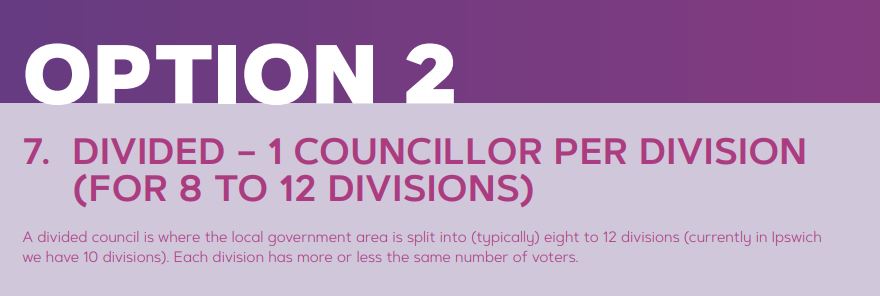
The people of Ipswich are being encouraged to have their say about how the city’s council will be represented at the March 2020 elections and beyond.
There are three options on divisional boundaries for consideration.
These are the pros and cons of each option.


Possible ADVANTAGES include that it:
+ Delivers a more unified, citywide, strategic focus to council governance.
+ Gives voters a choice of councillors they can approach with their concerns.
+ Promotes councillors, as per the Act, to address issues in the best interests of all residents in the local government area, as opposed to a ‘my backyard’ approach.
+ Leads to more integrated policy making.
+ Allows voters to express a preference for every candidate in the council election.
+ Allows voters to select candidates based on their capabilities as community leaders and decision makers across the whole local government area rather than just on their
geographic associations.
+ Results in a simpler voters’ roll for elections.
+ Avoids the requirement for regular divisional reviews (reviews needed to ensure the proportion of councillors to voters does not vary by more than 10 per cent between any division in the local government area).
Possible DISADVANTAGES include that:
+There are risks that most councillors will be elected from a single part of the local government area and that some ‘communities of interest’ could be unrepresented.
+ A councillor’s capacity for local engagement and representation may be diminished if they become inaccessible to residents in parts of the local government area.
+ Councillors’ responsibilities may become confused and their efforts duplicated if there is no clarity around roles and representation among the councillors.
+ It is a far more costly exercise for candidates to campaign across an entire local government area, as opposed to a division, which may disadvantage independent candidates who
do not have the financial backing to market themselves to the whole community.
+ It may make it difficult for voters to assess the performances of individual councillors across the local government area.


Possible ADVANTAGES include that it:
+ Encourages a diverse range of candidates to run for council as they only have to incur electoral campaign costs for a division (and not across the entire council area).
+ Allows for councillors to be truly local representatives (for their division), easily accessible to residents and more aware of local issues.
+ Ensures that geographically-formed ‘communities of interest’ are likely to be represented at council.
+ May contribute to ensuring that sectional interests are less likely to dominate the council.
Possible DISADVANTAGES include that:
+ Councillors might be elected on local, minor, or parochial issues and lack perspective on or offer less support for policies that benefit the whole council (ie a ‘my backyard’ approach).
+ Divisional boundaries might divide larger communities of interest and might be hard to define.
+ When this model is accompanied by other practices, such as the portfolio system in which areas of responsibility are allocated to individual councillors, the culture of the ‘lone councillor’ looking after ‘my patch’ is reinforced.
+ When combined with a divisional funding program (which was discontinued in Ipswich) that allocates funds to each councillor to dispense more or less unchallenged, a councillor can develop a preoccupation with funding for their own division rather than the priorities of the whole city.
+ A burden is placed on an individual councillor, as technically the only other councillor with an interest in that division is the mayor, who is elected by the whole of the city. This could distract the mayor from strategic obligations.
+ Voters might have fewer options to select from for their representative.
+ If a division has a high growth rate, boundaries will be more susceptible to change (as population changes put numbers above or below the 10 per cent quota), which could mean more regular reviews.


Possible ADVANTAGES include that it:
+ Offers all of the advantages cited for the divided – single representative model.
+ Supports representation of different interests in a division.
+ Allows for greater consideration of multiple views on issues than the single representation model as each division would be represented by more than 1 councillor.
+ Can make divisional boundaries easier to identify and less susceptible to change as a result of uneven growth population or decline than does the single representative model.
+ Provides councillors in a division with increased opportunity for discussion and shared responsibility.
+ Provides residents with 3 or 4 councillors to contact about issues – their 2 or 3 local ‘divisional’ councillors plus the relevant committee chair (if committees are utilised),
therefore increasing the level of local representation.
Possible DISADVANTAGES include that:
+ All of the disadvantages cited for the divided – single representative model may also be relevant.
+ Groups may come together along interest lines, leading to issues between divisional councillors.
+ Councillors may duplicate their efforts if they do not communicate or share their workloads effectively.
+ Different views on issues within a division may make these issues more difficult to resolve.

